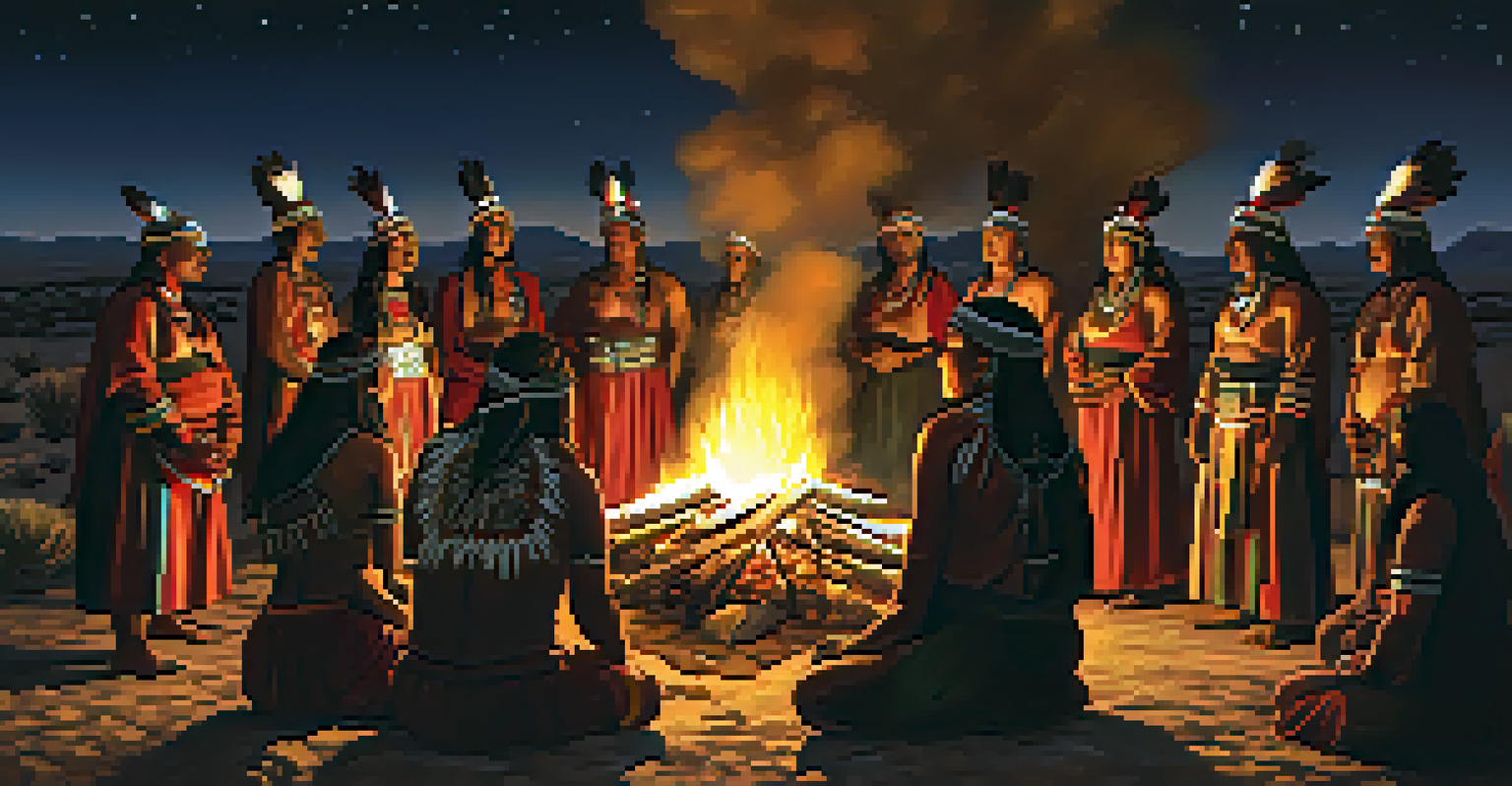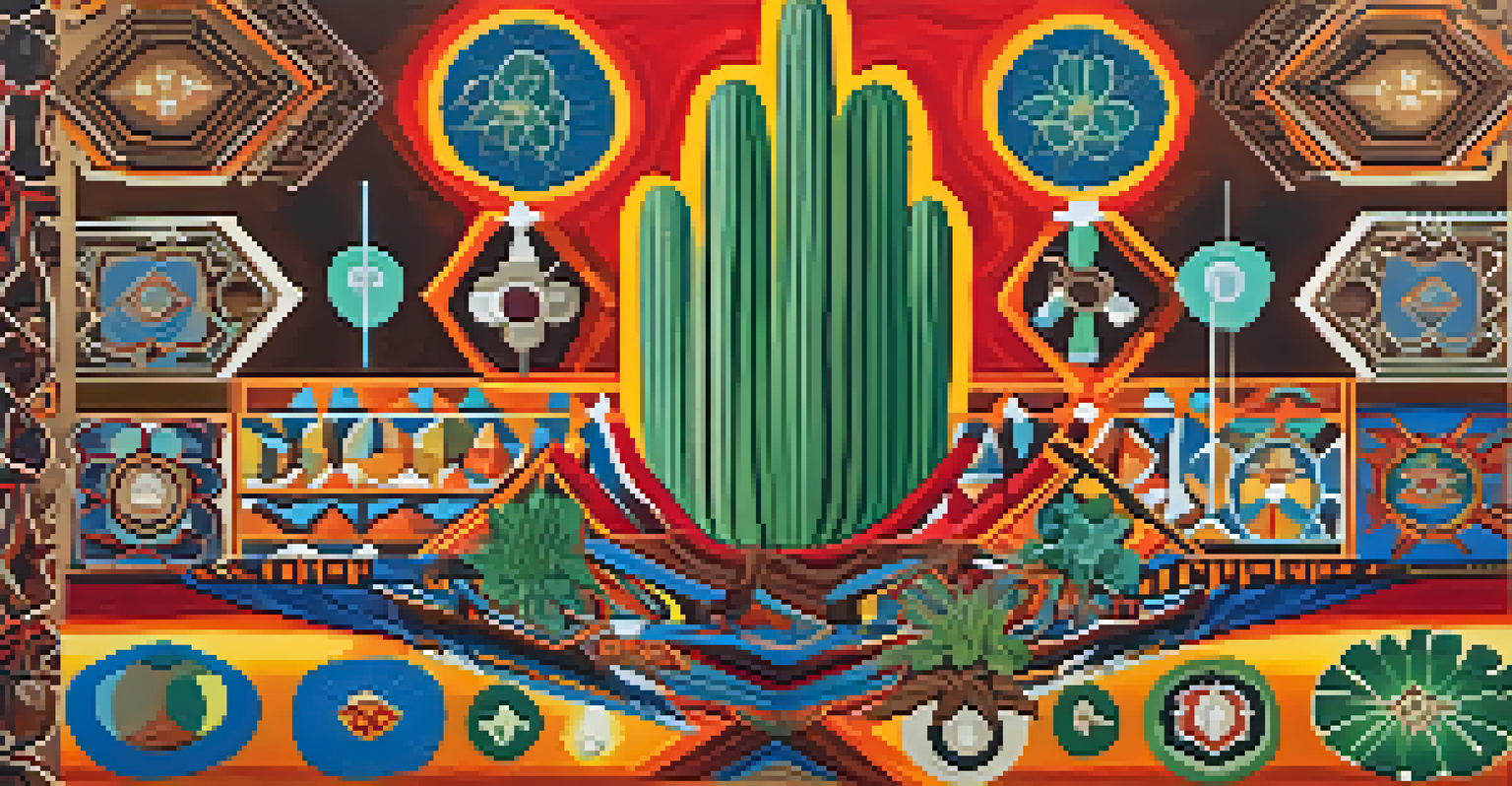Peyote: A Sacred Plant in Indigenous Spiritual Practices

The Historical Context of Peyote in Indigenous Cultures
Peyote, a small cactus native to the southwestern United States and Mexico, has been a part of Indigenous cultures for thousands of years. It is primarily known for its psychoactive properties, which have made it a sacred plant in various spiritual ceremonies. Indigenous peoples, such as the Huichol and the Navajo, have used peyote as a means of connecting with their ancestors and the spirit world.
The use of peyote is a way of connecting with the universe and understanding one's place within it.
The use of peyote dates back to ancient times, with archaeological evidence suggesting its consumption as early as 5,700 years ago. It played a central role in religious rituals, where it was believed to facilitate visions, healing, and guidance. This deep-rooted history underscores the importance of peyote in shaping the spiritual landscape of Indigenous communities.
In contemporary times, the use of peyote continues to be a vital aspect of Indigenous identity and cultural preservation. As these communities navigate the complexities of modern society, peyote remains a powerful symbol of resilience and spiritual continuity.
Psychoactive Properties and Spiritual Experiences
The active compound in peyote, mescaline, induces altered states of consciousness, which many users describe as profound and transformative. During ceremonies, participants often report experiencing vivid hallucinations and a deep sense of connection to the universe. This altered state is not merely recreational; it serves as a conduit for spiritual insight and healing.

Indigenous practitioners often prepare for peyote ceremonies through fasting and prayer, creating a sacred space that enhances the experience. The communal aspect of these ceremonies fosters a supportive environment, allowing individuals to explore their inner selves alongside others. This shared journey can lead to collective healing and a strengthened sense of community.
Peyote's Role in Indigenous Culture
Peyote serves as a sacred plant in Indigenous cultures, integral to spiritual ceremonies and cultural identity.
Many participants express that the peyote experience helps them confront personal challenges, gain clarity, and understand their place in the cosmos. These insights are seen as gifts from the plant, emphasizing the deep respect and reverence Indigenous cultures hold for peyote.
The Role of Peyote in Healing Practices
Peyote is not just a tool for spiritual exploration; it also plays a significant role in traditional healing practices. Indigenous healers often incorporate peyote into ceremonies designed to address physical, emotional, and spiritual ailments. This holistic approach recognizes the interconnectedness of mind, body, and spirit.
Cultural traditions are not just relics of the past; they are living practices that continue to shape our identities and communities.
During healing ceremonies, the effects of peyote are believed to facilitate deep introspection and emotional release, allowing participants to process trauma and grief. The plant is thought to reveal underlying issues that might be affecting a person's well-being, guiding them toward resolution and healing. This process is often accompanied by prayers, songs, and rituals that honor the spirit of peyote.
The use of peyote in healing underscores the importance of cultural context in understanding medicinal practices. For Indigenous peoples, the healing journey is as much about spiritual connection as it is about physical health, highlighting a unique approach to wellness that is deeply rooted in tradition.
Modern Challenges and Legal Status of Peyote
Despite its cultural significance, the use of peyote faces challenges in the modern world, particularly concerning legal status and conservation. In the United States, peyote is classified as a Schedule I substance, making its use illegal outside of recognized religious contexts. This classification poses a threat to Indigenous spiritual practices, as access to the plant becomes increasingly restricted.
Efforts are underway to protect the rights of Indigenous peoples to use peyote in their religious ceremonies, but these battles can be complex and fraught with legal hurdles. Many Indigenous leaders advocate for greater recognition of their cultural practices and the need to preserve peyote habitats, which are under threat from overharvesting and environmental changes.
Healing and Spiritual Insights
The psychoactive properties of peyote facilitate profound spiritual experiences and emotional healing during ceremonies.
The conversation around peyote and its legal status is evolving, with some advocating for its decriminalization. As society becomes more aware of the importance of cultural heritage and the rights of Indigenous peoples, there is hope for a more supportive framework that honors these sacred traditions.
Cultural Significance Beyond the Ceremony
Peyote's significance extends beyond the ceremonial use; it embodies the cultural identity and resilience of Indigenous communities. The act of gathering for peyote ceremonies reinforces social bonds and serves as a means of cultural transmission, where knowledge and traditions are passed down through generations. This communal aspect is vital for maintaining cultural heritage in a rapidly changing world.
For many Indigenous people, peyote is a symbol of resistance against colonial forces that have sought to erase their traditions. By continuing to practice peyote rituals, these communities assert their sovereignty and the importance of their cultural narratives. This reclamation of identity fosters pride and solidarity, empowering individuals to embrace their heritage.
The cultural significance of peyote also extends to contemporary art, literature, and activism, where it inspires creative expression and advocacy. Artists and writers draw on the imagery and themes associated with peyote to highlight Indigenous perspectives, bridging the gap between past and present.
Educational Efforts and Respectful Engagement
As interest in peyote grows, so does the need for educational efforts that promote respectful engagement with Indigenous cultures. Understanding the historical and cultural context of peyote is crucial for anyone seeking to explore its use. This knowledge helps prevent cultural appropriation and ensures that Indigenous voices are heard and respected.
Workshops, lectures, and community events hosted by Indigenous leaders can provide valuable insights into the significance of peyote and the ethics of its use. These initiatives encourage dialogue and foster a deeper appreciation for the complexity of Indigenous spirituality. Engaging with these communities in a respectful manner is essential for building trust and mutual understanding.
Challenges Facing Peyote Practices
Legal restrictions and environmental threats pose significant challenges to the preservation of peyote and its use in Indigenous spirituality.
Ultimately, the goal of these educational efforts is to create a space where people can learn about and appreciate the role of peyote in Indigenous cultures without exploiting or commodifying it. By honoring the sacredness of the plant and its cultural significance, we can contribute to a more inclusive and respectful society.
The Future of Peyote in Indigenous Spirituality
The future of peyote in Indigenous spirituality is intertwined with the ongoing efforts to protect and revitalize cultural practices. As younger generations become increasingly interested in their heritage, there is a renewed commitment to preserving peyote traditions. This resurgence is vital for ensuring that the spiritual and cultural significance of peyote endures.
However, challenges such as environmental degradation, climate change, and legal restrictions pose threats to both peyote populations and Indigenous practices. Efforts to cultivate peyote sustainably and advocate for its legal protection are essential to safeguard this sacred plant for future generations. Indigenous leaders are actively working to address these issues while fostering a sense of responsibility toward the land.

In navigating these challenges, there is hope for a future where peyote can continue to serve as a bridge between past and present. By honoring its role in Indigenous spirituality, we can contribute to a richer understanding of cultural diversity and the importance of protecting sacred traditions.